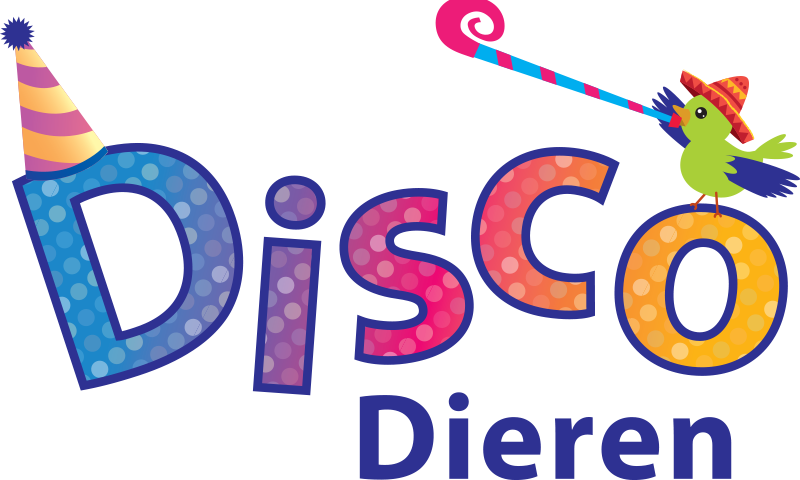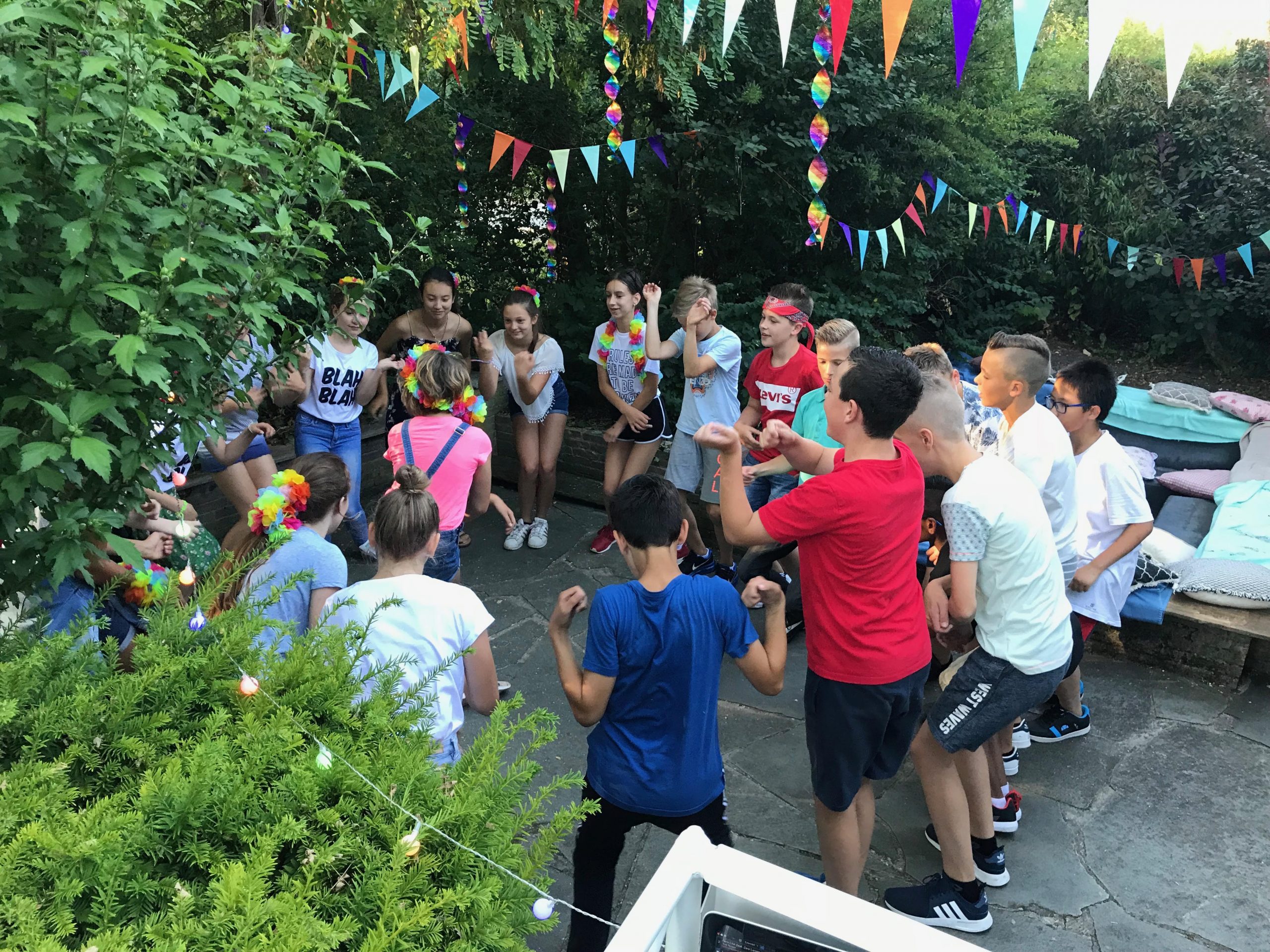It is very important to match the games and music during a children’s disco party to the age of the children. It should certainly not be too difficult but not too childish/easy either. That is why I have put an age indication with the different games. With some modifications, almost any game can be played with children of any age.
Note: Many parents have a time schedule in their heads. Already assume that that schedule will be completely different. One group is so fed up with a game while another group wants to play this game several times in a row. Always be flexible and make sure you have enough prepared. Preferably explain the games amplified (microphone and speakers), after all, there are a lot of kids in front of you.
During a children’s disco by DiscoAnimal, the games are not fixed in advance. It may be that we will play one or more of the games below; but it may also be that a can of other games will be opened. Some games I make up on the spot by something that comes to mind or by something one of the children does.
Live chair dance (10-13 years)
One of my personal favorites is the living chair dance. This involves splitting the group into two groups, for example, boys and girls. One group plays the chairs, the other group plays the game.
Have the living chairs sit in a circle on the floor with their legs slightly wide. Once the music starts the players must walk around the “chairs,” when the music stops they must sit with someone between their legs. Are there two players between a pair of legs? Then have them play rock-paper-scissors to see who gets to move on to the next round. Of course, you send away one or two chairs each round.
Unequal teams? No problem. If you have too many “chairs” let all the chairs leave that don’t have a player between their legs in the first round. Do you have too many players? Then a lot of players drop out in the first round.
Balloon stamping (7 – 13 years)
Each child is given a balloon with a string attached to it. You can inflate them yourself beforehand, but with older children, of course, let them do it themselves. You can make your own strings to the balloons, however, it is easy to get “punch” balloons, which are balloons with an elastic band attached.
Each child attaches the balloon to his leg. The idea is to stomp other people’s balloons to pieces so that in the end only one child is left with a balloon at his/her feet: the winner. Is your own balloon broken? Then, of course, you may no longer participate.
Balloon dancing (7 – 13 years)
Have the children form pairs/triplets. Each pair/triplet is given a balloon, which must be inflated and a knot tied in this.
The children must dance with the balloon between their bellies without touching the balloon with their arms/hands. Does the balloon fall/snap or do they use their hands? Then you are finished.
To prevent the children from “cheating” and not moving/dancing, also give them assignments (not completing an assignment is also finished), for example:
Hands in the air
Taking a spin together
Taking turns around the axis
Jump
Some children can keep this up for a long time, so it is important to build in some kind of “finale. The two I use are:
- The group that is the first to pop the balloon without using their hands
- The group that first has the balloon between their heads without using their hands
Which final you choose depends mainly on the children; some children are very afraid of balloons.
Tip: After this game, let the children free-dance with the remaining balloons for a while; does that get out of hand? Play a short game of who pops the most balloons.
Stop Dance (7-10 years)
The stop dance, of course, is centuries old and in fact everyone knows it. Do you know him yet? Then the children probably know him. Very simple; when you hear music you have to dance, when the music stops you have to stand completely still right away. Are you not standing still in time? Then, of course, you are finished.
Tip: Designate one of the children, such as the birthday boy, who gets to watch who is not standing still on time.
Circle dance (7-13 years)
Another one of my personal favorites is the circle dance. Mostly because it’s actually always a success. Have the children stand in a circle and designate a child to stand in the middle. The explanation is short and clear, there is always a child dancing in the middle and everyone dances after him/her, when the dancer is done then he/she points to the next one.
Tip: explain that no one is obligated to dance in the middle, if someone doesn’t want to he/she doesn’t have to; if you don’t say this, the game can suddenly derail considerably.
Musician (6-10 years)
Musician is a quiet game; you cannot expect children to sing, jump and dance for 2 hours. Therefore, play a quiet game, such as this one, in between.
In musician, all the children sit in a circle and there is one musician. The musician makes a movement that all children must imitate, for example, clapping, drumming your head, etc.
Before you designate the musician as game leader send away n child, as he/she has to go in three guesses who is the musician of the orchestra.
Drawing cards (11-13 years)
At a grade 7 / grade 8 party, it is of course hearty fun to have the children slow/shuffle. In fact, I would argue that a grade 8 party has failed if not tried. However, young adolescents absolutely do not slow down on their own (with exceptions), so we have to help them a little.
Count in advance how many boys and girls will attend the party, in this example we will assume 15 boys and 14 girls. Since the largest group consists of 15, we pack 15 cards. What kind of cards? A set of old playing cards or an old quartet game.
Making sure you have two bins: one for the girls and one for the boys, cut the 15 cards into tween. One half goes in the boys’ bin, the other half in the girls’ bin.
If you want to start playing this game, have the children grab half a card themselves from the correct bin (fate decides). Have the children find their other half (the boy with the two of spades should find the girl with the heart two). It is important to explain that they have not found their dance partner until everyone has found the dance partner!
Tip: attach a prize to the most romantic couple.
Tip: slow down on a quiet top 40 record. At the end of the school year, when grade 8 has to say goodbye to each other, a song like “Goodbye Doesn’t Exist,” “Hold Me” or “This No One Will Take Away From Us” can run your entire party.
Since you are reading this game I am almost certain you are going to have a grade 8 party. Also read my blog with tips for your grade 8 disco.
Games with music
Provide appropriate music for each game. Try not to go from game to game; make sure the children can have a good dance in between; that gives you the opportunity to prepare the next game.
Good luck with the preparations
Still not comfortable doing everything yourself and prefer to outsource the entertainment at the birthday party? Check out the options or email us; team@discodieren.nl. Did you throw a super fun party using these tips or do you have tips for others? Then, of course, we would love to hear about it.



